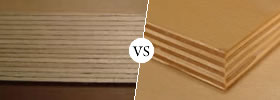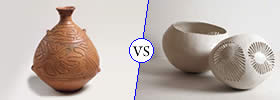Difference between Cleavage and Fracture
Key Difference: In mineralogy, cleavage and fracture both describe a tendency of a mineral to break. In cleavage, a mineral may split apart along various smooth planes. These smooth planes are parallel to zones of weak bonding. On the other hand, fracture breaks a mineral along the curved surface with irregular shapes. The minerals that undergo fracture do not have planes of weakness, and therefore break in an irregular manner.
.jpg) Cleavage describes a way in which a mineral breaks into flat surfaces. The number of flat surfaces usually range from one to four. This behavior is defined by the crystal structure of the mineral. Cleavage can be simply defined as the property of some minerals to break along specific planes in the crystal. The reason behind the planes of weakness is the weak bonding between the atoms that constitutes a mineral. Thus, cleavage can be associated with the atomic arrangement of a mineral.
Cleavage describes a way in which a mineral breaks into flat surfaces. The number of flat surfaces usually range from one to four. This behavior is defined by the crystal structure of the mineral. Cleavage can be simply defined as the property of some minerals to break along specific planes in the crystal. The reason behind the planes of weakness is the weak bonding between the atoms that constitutes a mineral. Thus, cleavage can be associated with the atomic arrangement of a mineral.
Cleavage is often measured by three factors:
- Quality of cleavage
- Number of sides exhibiting cleavage
- Cleavage habit
It is also important to describe the angle between the cleavage planes. For example, if a mineral is in the shape of a cube then the angle between the cleavage planes should be 90°.

Fracture breaks a mineral along the curved surface with irregular shapes. The minerals that undergo fracture do not have planes of weakness, and therefore break in an irregular manner. Fracture exhibits a more random way of breaking than compared to cleavage. It occurs, as the bonds between all the atoms of the mineral are roughly equal. Thus, there are no layers of weakness like in the case of cleavage. Therefore, the mineral breaks in a random manner.
Fracture helps in the identification of the mineral, and therefore is considered to be one of the various properties including: streak, specific gravity, crystal structure, luster, color, hardness, flame test and others. Cleavage planes can be easily distinguished from a fracture as they are smooth and often have reflective surfaces.
Comparison between Cleavage and Fracture:
|
|
Cleavage |
Fracture |
|
Definition |
In cleavage, a mineral may split apart along various smooth planes. These smooth planes are parallel to zones of weak bonding. |
Fracture breaks a mineral along the curved surface with irregular shapes. |
|
Types |
There are five types of cleavage:
|
There are five types of fracture:
|
|
Examples |
Halite, mica, and calcite |
Quartz and obsidian |
|
Reason |
Inherent weaknesses within a mineral's atomic structures. |
No planes of weakness in a mineral's atomic structure. |
Images Courtesy: geology.csupomona.edu









Comments
Sandy
Sun, 12/10/2017 - 16:49
Add new comment